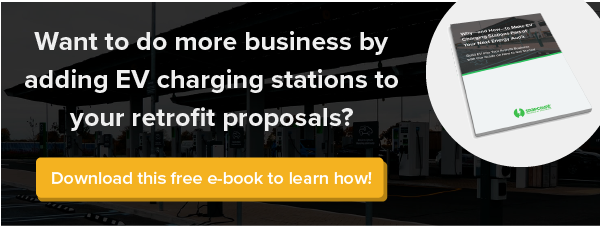
Just a few years ago, electric vehicle (EV) sightings on the highway were about as rare as those of antique roadsters. Fast forward to today, and it seems like every tenth car is whirring along silently under the power of an electric motor.
EV technology is improving and becoming more affordable. Auto manufacturers are electrifying their lineups. And consumers fed up with high gas prices and pollution are increasingly attracted to clean electric vehicles.
It won’t be long before fossil fuel-powered vehicles are the rarity, which raises a question: Where will all these EVs recharge their batteries?
You’ve undoubtedly already noticed EV charging stations popping up along roadsides and in parking lots all over America. Still, there’s quite a ways to go before the demand for commercial charging stations is met: According to the World Economic Forum, nearly 300 million EV charging stations must be deployed worldwide by 2040, including 11 million workplace chargers, 23 million public chargers, and 4 million fleet chargers.
This global expansion of EV charging infrastructure will require an investment that exceeds half a trillion dollars worldwide, which raises another question: Who will install (and profit from installing) all these commercial EV charging stations?
The answer, potentially, might be your company.
Why Add Commercial EV Charging Stations to Your Retrofit Services?
As the world electrifies, EV charging stations make a natural add-on to the sustainability upgrades your company already provides, such as LED lighting retrofits.
Many of your customers may already be considering installing EV charging stations within the next three years. But even if they still consider EV charging a “backburner item,” any organization with a significant number of customers or employees who travel by car (basically, any organization with a parking lot) should be aware that charging capabilities must be available sooner or later.
By offering commercial charging station installation now, you can position your company as a market innovator.
It can also help get your foot in the door for future projects: Many companies will look to expand their charging capacity as the demand grows over the next several years. They will most likely choose the provider that installed their first units — provided they were satisfied with the results.
What Should Your Commercial EV Charging Station Service Include?
We’re not just talking about installation when we talk about adding commercial EV charging (also known as electric vehicle supply equipment, or EVSE) to your business’s services. Other aspects of EVSE service include:
- Education. The EV charging market is still relatively new. Your customers may need help understanding the EV charger installation process, costs, and benefits.
- Retrofitting of older equipment.
- Service and upgrades, including warranty work.
- Replacing EV charging equipment as it ages and improved equipment becomes available.
4 Tools You’ll Need to Develop an EVSE Offering
Like most retrofit and installation projects, specialized tools can help you specify EVSE and generate proposals accurately and efficiently. If you’re preparing to add commercial EV charging station installation to your company’s services, empower your team with these essentials:
1. A Mapping Utility
An EVSE offering requires mapping on two fronts:
- Inside the building, including where equipment must be modified and where electrical service panels must be placed.
- Outside the building where the EV charging stations will be located (which may be in a parking garage or a parking lot).
2. Photos and Markup Ability
You can use photos to depict specific locations for EV charging equipment and the obstacles that might complicate the installation. A 360-degree camera can ensure that every detail is captured from every possible angle. A markup tool will allow you to add distances, notes, and labels directly onto the photo.
3. Specific Questions to Guide Labor and Equipment Quotes
During an EV charging station audit, auditors must gather some very specific data points to determine how to install and configure the chargers to meet the needs of building owners and users. Auditing software like SnapCount can guide auditors with questions based on research, input from EV charging manufacturers, and feedback from other users.
4. The Ability to Roll Up Labor and Material to a Deliverable Proposal
Integrating costs and benefits for materials and labor into a cohesive proposal conveys to prospects the confidence that all your bases are covered. When possible, combine your EVSE proposals with your LED lighting retrofit proposals.
Why Should You Conduct Your Commercial EV Charging Station Audits Digitally?
As your business embraces the potential of commercial EV charging services, your first instinct may be to continue relying on the same pencil-and-paper auditing and proposal creation techniques that have sustained your company so far.
But the addition of EVSE to your services is the perfect opportunity for a digital upgrade.
EVSE only increases the complexity of your retrofit projects, which also increases the likelihood of human error when transcribing manual inputs. Handwritten notes are easy to misread, destroy, or lose and lend themselves to mathematical and detail errors. Besides, EV charging stations are cutting-edge technology. Completing audits with pencil and paper will make customers question whether your company has truly mastered something as advanced as EV charging.
As we mentioned above, most building owners are still fairly unfamiliar with the nuances of EV charging. Successfully closing a deal that includes commercial EV charging stations may require a substantial amount of educating.
A well-designed digital proposal — built off data collected using digital auditing tools — can help your clients visualize the value of commercial EV charging stations and demonstrate where they fit within the context of a larger retrofit project. This means more and larger contracts for your business, with customers returning regularly for upgrades as the EV revolution advances.







Share this post: